Morphology Controlled Fabrication of InN Nanowires on Brass Substrates
Abstract
:1. Introduction
2. Experimental
3. Results and Discussion
3.1. Morphology and Structural Characterization
3.2. Effect of the Growth Temperature
3.3. Growth Mechanisms of the Nanowires
3.4. Growth of Multi-Section Nanowires
4. Conclusions
Supplementary Materials
Acknowledgments
Author Contributions
Conflicts of Interest
References
- Pust, P.; Schmidt, P.J.; Schnick, W. A revolution in lighting. Nat. Mater. 2015, 14, 454–458. [Google Scholar] [CrossRef] [PubMed]
- Taniyasu, Y.; Kasu, M.; Makimoto, T. An aluminium nitride light-emitting diode with a wavelength of 210 nanometres. Nature 2006, 441, 325–328. [Google Scholar] [CrossRef] [PubMed]
- Zhao, Y.; Tanaka, S.; Yan, Q.; Huang, C.-Y.; Chung, R.B.; Pan, C.-C.; Fujito, K.; Feezell, D.; Van de Walle, C.G.; Speck, J.S.; et al. High optical polarization ratio from semipolar (20-2-1) blue-green InGaN/GaN light-emitting diodes. Appl. Phys. Lett. 2011, 99, 051109. [Google Scholar] [CrossRef]
- Ariyawansa, G.; Rinzan, M.B.M.; Alevli, M.; Strassburg, M.; Dietz, N.; Perera, A.G.U.; Matsik, S.G.; Asghar, A.; Ferguson, I.T.; Luo, H.; et al. GaN/AlGaN ultraviolet/infrared dual-band detector. Appl. Phys. Lett. 2006, 89, 091113. [Google Scholar] [CrossRef]
- Babichev, A.V.; Zhang, H.; Lavenus, P.; Julien, F.H.; Egorov, A.Y.; Lin, Y.T.; Tu, L.W.; Tchernycheva, M. GaN nanowire ultraviolet photodetector with a graphene transparent contact. Appl. Phys. Lett. 2013, 103, 201103. [Google Scholar] [CrossRef]
- Adachi, M.; Yoshizumi, Y.; Enya, Y.; Kyono, T.; Sumitomo, T.; Tokuyama, S.; Takagi, S.; Sumiyoshi, K.; Saga, N.; Ikegami, T.; et al. Low threshold current density InGaN based 520–530 nm green laser diodes on semi-polar {20–21} free-standing GaN substrates. Appl. Phys. Express 2010, 3, 121001. [Google Scholar] [CrossRef]
- Adachi, M. InGaN based green laser diodes on semipolar GaN substrate. Jap. J. Appl. Phys. 2014, 53, 100207. [Google Scholar] [CrossRef]
- Li, Y.; Xiang, J.; Qian, F.; Gradečak, S.; Wu, Y.; Yan, H.; Blom, D.A.; Lieber, C.M. Dopant-free GaN/AlN/AlGaN radial nanowire heterostructures as high electron mobility transistors. Nano Lett. 2006, 6, 1468–1473. [Google Scholar] [CrossRef] [PubMed]
- Li, D.; Sun, X.; Song, H.; Li, Z.; Chen, Y.; Jiang, H.; Miao, G. Realization of a high-performance GaN UV detector by nanoplasmonic enhancement. Adv. Mater. 2012, 24, 845–849. [Google Scholar] [CrossRef] [PubMed]
- Chen, Z.; Pei, Y.; Newman, S.; Chu, R.; Brown, D.; Chung, R.; Keller, S.; Denbaars, S.P.; Nakamura, S.; Mishra, U.K. Growth of AlGaN/GaN heterojunction field effect transistors on semi-insulating GaN using an AlGaN interlayer. Appl. Phys. Lett. 2009, 94, 112108. [Google Scholar] [CrossRef]
- Jiang, L.F.; Shen, W.Z.; Guo, Q.X. Temperature dependence of the optical properties of AllnN. J. Appl. Phys. 2009, 106, 013515. [Google Scholar] [CrossRef]
- Schley, P.; Goldhahn, R.; Winzer, A.T.; Gobsch, G.; Cimalla, V.; Ambacher, O.; Lu, H.; Schaff, W.J.; Kurouchi, M.; Nanishi, Y.; et al. Dielectric function and Van Hove singularities for In-rich InxGa1−xN alloys: Comparison of N- and metal-face materials. Phys. Rev. B 2007, 75, 205204. [Google Scholar] [CrossRef]
- Sakalauskas, E.; Behmenburg, H.; Hums, C.; Schley, P.; Rossbach, G.; Giesen, C.; Heuken, M.; Kalisch, H.; Jansen, R.H.; Bläsing, J.; et al. Dielectric function and optical properties of Al-rich AllnN alloys pseudomorphically grown on GaN. J. Phys. D Appl. Phys. 2010, 43, 365102. [Google Scholar] [CrossRef]
- Neufeld, C.J.; Toledo, N.G.; Cruz, S.C.; Iza, M.; DenBaars, S.P.; Mishra, U.K. High quantum efficiency InGaN/GaN solar cells with 2.95 eV band gap. Appl. Phys. Lett. 2008, 93, 143502. [Google Scholar] [CrossRef]
- Seo, D.-J.; Shim, J.-P.; Choi, S.-B.; Seo, T.H.; Suh, E.-K.; Lee, D.-S. Efficiency improvement in InGaN-based solar cells by indium tin oxide nano dots covered with ITO films. Opt. Express 2012, 20, A991–A996. [Google Scholar] [CrossRef] [PubMed]
- Howell, S.L.; Padalkar, S.; Yoon, K.; Li, Q.; Koleske, D.D.; Wierer, J.J.; Wang, G.T.; Lauhon, L.J. Spatial mapping of efficiency of GaN/ InGaN nanowire array solar cells using scanning photocurrent microscopy. Nano Lett. 2013, 13, 5123–5128. [Google Scholar] [CrossRef] [PubMed]
- Jung, H.S.; Hong, Y.J.; Li, Y.; Cho, J.; Kim, Y.-J.; Yi, G.-C. Photocatalysis using GaN nanowires. ACS Nano 2008, 2, 637–642. [Google Scholar] [CrossRef] [PubMed]
- Cao, D.; Xiao, H.; Xu, H.; Cui, J.; Gao, Q.; Pei, H. Enhancing the photocatalytic activity of GaN by electrochemical etching. Mater. Res. Bull. 2015, 70, 881–886. [Google Scholar] [CrossRef]
- Purushothaman, V.; Prabhu, S.; Jothivenkatachalam, K.; Parthiban, S.; Kwon, J.Y.; Jeganathan, K. Photocatalytic dye degradation properties of wafer level GaN nanowires by catalytic and self-catalytic approach using chemical vapor deposition. RSC Adv. 2014, 4, 25569. [Google Scholar] [CrossRef]
- Alvi, N.H.; Soto Rodriguez, P.E.D.; Aseev, P.; Gómez, V.J.; Alvi, A.H.; Hassan, W.; Willander, M.; Nötzel, R. InN/InGaN quantum dot photoelectrode: Efficient hydrogen generation by water splitting at zero voltage. Nano Energy 2015, 13, 291–297. [Google Scholar] [CrossRef]
- Benton, J.; Bai, J.; Wang, T. Utilisation of GaN and InN/InGaN with nanoporous structures for water splitting. Appl. Phys. Lett. 2014, 105, 223902. [Google Scholar] [CrossRef]
- Kibria, M.G.; Zhao, S.; Chowdhury, F.A.; Wang, Q.; Nguyen, H.P.; Trudeau, M.L.; Guo, H.; Mi, Z. Tuning the surface fermi level on p-type gallium nitride nanowires for efficient overall water splitting. Nat. Commun. 2014, 5, 3825. [Google Scholar] [CrossRef] [PubMed]
- Yu, R.; Wu, W.; Ding, Y.; Wang, Z.L. GaN nanobelt-based strain-gated piezotronic logic devices and computation. ACS Nano 2013, 7, 6403–6409. [Google Scholar] [CrossRef] [PubMed]
- Yu, R.; Wang, X.; Pen, W.; Wu, W.; Ding, Y.; Li, S.; Wang, Z.L. Piezotronic effect in strain-gated transistor of a-axis GaN nanobelt. ACS Nano 2015, 9, 9822–9829. [Google Scholar] [CrossRef] [PubMed]
- Wang, C.H.; Lai, K.Y.; Li, Y.C.; Chen, Y.C.; Liu, C.P. Ultrasensitive thin-film-based AlxGa1−xN piezotronic strain sensors via alloying-enhanced piezoelectric potential. Adv. Mater. 2015, 27, 6289–6295. [Google Scholar] [CrossRef] [PubMed]
- Choi, J.H.; Cho, E.H.; Lee, Y.S.; Shim, M.-B.; Ahn, H.Y.; Baik, C.-W.; Lee, E.H.; Kim, K.; Kim, T.-H.; Kim, S.; et al. Fully flexible GaN light-emitting diodes through nanovoid-mediated transfer. Adv. Opt. Mater. 2014, 2, 267–274. [Google Scholar] [CrossRef]
- Kobayashi, Y.; Kumakura, K.; Akasaka, T.; Makimoto, T. Layered boron nitride as a release layer for mechanical transfer of GaN-based devices. Nature 2012, 484, 223–227. [Google Scholar] [CrossRef] [PubMed]
- Makimoto, T.; Kumakura, K.; Kobayashi, Y.; Akasaka, T.; Yamamoto, H. A vertical InGaN/GaN light-emitting diode fabricated on a flexible substrate by a mechanical transfer method using BN. Appl. Phys. Express 2012, 5, 072102. [Google Scholar] [CrossRef]
- Chung, K.; Lee, C.H.; Yi, G.C. Transferable GaN layers grown on ZnO-coated graphene layers for optoelectronic devices. Science 2010, 330, 655–657. [Google Scholar] [CrossRef] [PubMed]
- Kim, J.; Bayram, C.; Park, H.; Cheng, C.W.; Dimitrakopoulos, C.; Ott, J.A.; Reuter, K.B.; Bedell, S.W.; Sadana, D.K. Principle of direct van der waals epitaxy of single-crystalline films on epitaxial graphene. Nat. Commun. 2014, 5, 4836. [Google Scholar] [CrossRef] [PubMed]
- Xiong, K.; Park, S.H.; Song, J.; Yuan, G.; Chen, D.; Leung, B.; Han, J. Single crystal gallium nitride nanomembrane photoconductor and field effect transistor. Adv. Funct. Mater. 2014, 24, 6503–6508. [Google Scholar] [CrossRef]
- Huang, S.; Zhang, Y.; Leung, B.; Yuan, G.; Wang, G.; Jiang, H.; Fan, Y.; Sun, Q.; Wang, J.; Xu, K.; et al. Mechanical properties of nanoporous GaN and its application for separation and transfer of GaN thin films. ACS Appl. Mater. Int. 2013, 5, 11074–11079. [Google Scholar] [CrossRef] [PubMed]
- Tsakalakos, L.; Balch, J.; Fronheiser, J.; Korevaar, B.A.; Sulima, O.; Rand, J. Silicon nanowire solar cells. Appl. Phys. Lett. 2007, 91, 233117. [Google Scholar] [CrossRef]
- Yuan, F.-W.; Yang, H.-J.; Tuan, H.-Y. Seeded silicon nanowire growth catalyzed by commercially available bulk metals: Broad selection of metal catalysts, superior field emission performance, and versatile nanowire/metal architectures. J. Mater. Chem. 2011, 21, 13793. [Google Scholar] [CrossRef]
- Geaney, H.; Dickinson, C.; Barrett, C.A.; Ryan, K.M. High density germanium nanowire growth directly from copper foil by self-induced solid seeding. Chem. Mater. 2011, 23, 4838–4843. [Google Scholar] [CrossRef]
- Richards, B.T.; Gaskey, B.; Levin, B.D.A.; Whitham, K.; Muller, D.; Hanrath, T. Direct growth of germanium and silicon nanowires on metal films. J. Mater. Chem. C 2014, 2, 1869. [Google Scholar] [CrossRef]
- Ngo-Duc, T.-T.; Gacusan, J.; Kobayashi, N.P.; Sanghadasa, M.; Meyyappan, M.; Oye, M.M. Controlled growth of vertical ZnO nanowires on copper substrate. Appl. Phys. Lett. 2013, 102, 083105. [Google Scholar] [CrossRef]
- Xia, Y.; Zhang, Y.; Yu, X.; Chen, F. Low-temperature solution growth of ZnO nanocone/highly oriented nanorod arrays on copper. J. Phys. Chem. B 2014, 118, 12002–12007. [Google Scholar] [CrossRef] [PubMed]
- Wolz, M.; Hauswald, C.; Flissikowski, T.; Gotschke, T.; Fernandez-Garrido, S.; Brandt, O.; Grahn, H.T.; Geelhaar, L.; Riechert, H. Epitaxial growth of GaN nanowires with high structural perfection on a metallic tin film. Nano Lett. 2015, 15, 3743–3747. [Google Scholar] [CrossRef] [PubMed]
- Sarwar, A.G.; Carnevale, S.D.; Yang, F.; Kent, T.F.; Jamison, J.J.; McComb, D.W.; Myers, R.C. Semiconductor nanowire light-emitting diodes grown on metal: A direction toward large-scale fabrication of nanowire devices. Small 2015, 11, 5402–5408. [Google Scholar] [CrossRef] [PubMed]
- Zhao, C.; Ng, T.K.; Wei, N.; Prabaswara, A.; Alias, M.S.; Janjua, B.; Shen, C.; Ooi, B.S. Facile formation of high-quality InGaN/GaN quantum-disks-in-nanowires on bulk-metal substrates for high-power light-emitters. Nano Lett. 2016, 16, 1056–1063. [Google Scholar] [CrossRef] [PubMed]
- May, B.J.; Sarwar, A.T.M.G.; Myers, R.C. Nanowire leds grown directly on flexible metal foil. Appl. Phys. Lett. 2016, 108, 141103. [Google Scholar] [CrossRef]
- Xu, G.; Li, Z.; Baca, J.; Wu, J. Probing nucleation mechanism of self-catalyzed InN nanostructures. Nanoscale Res. Lett. 2009, 5, 7–13. [Google Scholar] [CrossRef] [PubMed]
- Ahn, H.; Liu, Y.-S.; Chang, K.-Y.; Gwo, S. Photoluminescence from InN nanorod arrays with a critical size. Appl. Phys. Express 2013, 6, 062103. [Google Scholar] [CrossRef]
- Shen, C.H.; Chen, H.Y.; Lin, H.W.; Gwo, S.; Klochikhin, A.A.; Davydov, V.Y. Near-infrared photoluminescence from vertical InN nanorod arrays grown on silicon: Effects of surface electron accumulation layer. Appl. Phys. Lett. 2006, 88, 253104. [Google Scholar] [CrossRef]
- Alvi, N.H.; Rodriguez, P.E.D.S.; Gómez, V.J.; Kumar, P.; Willander, M.; Nötzel, R. Highly sensitive and fast anion-selective InN quantum dot electrochemical sensors. Appl. Phys. Express 2013, 6, 115201. [Google Scholar] [CrossRef]
- Alvi, N.H.; Soto Rodriguez, P.E.D.; Gómez, V.J.; Kumar, P.; Amin, G.; Nur, O.; Willander, M.; Nötzel, R. Highly efficient potentiometric glucose biosensor based on functionalized InN quantum dots. Appl. Phys. Lett. 2012, 101, 153110. [Google Scholar] [CrossRef] [Green Version]
- Lu, Y.-S.; Huang, C.-C.; Yeh, J.A.; Chen, C.-F.; Gwo, S. InN-based anion selective sensors in aqueous solutions. Appl. Phys. Lett. 2007, 91, 202109. [Google Scholar] [CrossRef]
- Huang, C.T.; Song, J.; Tsai, C.M.; Lee, W.F.; Lien, D.H.; Gao, Z.; Hao, Y.; Chen, L.J.; Wang, Z.L. Single-InN-nanowire nanogenerator with upto 1 V output voltage. Adv. Mater. 2010, 22, 4008–4013. [Google Scholar] [CrossRef] [PubMed]
- Ku, N.J.; Huang, J.H.; Wang, C.H.; Fang, H.C.; Liu, C.P. Crystal face-dependent nanopiezotronics of an obliquely aligned inn nanorod array. Nano Lett. 2012, 12, 562–568. [Google Scholar] [CrossRef] [PubMed]
- Li, H.; Zhao, G.; Wei, H.; Wang, L.; Chen, Z.; Yang, S. Growth of well-aligned InN nanorods on amorphous glass substrates. Nanoscale Res. Lett. 2016, 11, 270. [Google Scholar] [CrossRef] [PubMed]
- Song, H.; Yang, A.; Zhang, R.; Guo, Y.; Wei, H.; Zheng, G.; Yang, S.; Liu, X.; Zhu, Q.; Wang, Z. Well-aligned Zn-doped InN nanorods grown by metal-organic chemical vapor deposition and the dopant distribution. Cryst. Growth Des. 2009, 9, 3292–3295. [Google Scholar] [CrossRef]
- Song, H.; Guo, Y.; Yang, A.; Wei, H.; Xu, X.; Liu, J.; Yang, S.; Liu, X.; Zhu, Q.; Wang, Z. The role of zinc dopant and the temperature effect on the controlled growth of InN nanorods in metal–organic chemical vapor deposition system. CrystEngComm 2010, 12, 3936–3941. [Google Scholar] [CrossRef]
- Zhang, B.; Song, H.; Xu, X.; Liu, J.; Wang, J.; Liu, X.; Yang, S.; Zhu, Q.; Wang, Z. Well-aligned Zn-doped tilted InN nanorods grown on r-plane sapphire by MOCVD. Nanotechnology 2011, 22, 235603. [Google Scholar] [CrossRef] [PubMed]
- Kang, T.-T.; Liu, X.; Zhang, R.Q.; Hu, W.G.; Cong, G.; Zhao, F.-A.; Zhu, Q. InN nanoflowers grown by metal organic chemical vapor deposition. Appl. Phys. Lett. 2006, 89, 071113. [Google Scholar] [CrossRef]
- Li, H.; Zhao, G.; Kong, S.; Han, D.; Wei, H.; Wang, L.; Chen, Z.; Yang, S. Morphology and composition controlled growth of polar c-axis and nonpolar m-axis well-aligned ternary iii-nitride nanotube arrays. Nanoscale 2015, 7, 16481–16492. [Google Scholar] [CrossRef] [PubMed]
- Mohammad, S.N. Why droplet dimension can be larger than, equal to, or smaller than the nanowire dimension. J. Appl. Phys. 2009, 106, 104311. [Google Scholar] [CrossRef]
- Tu, C.G.; Su, C.Y.; Liao, C.H.; Hsieh, C.; Yao, Y.F.; Chen, H.T.; Lin, C.H.; Weng, C.M.; Kiang, Y.W.; Yang, C.C. Regularly patterned multi-section GaN nanorod arrays grown with a pulsed growth technique. Nanotechnology 2016, 27, 025303. [Google Scholar] [CrossRef] [PubMed]
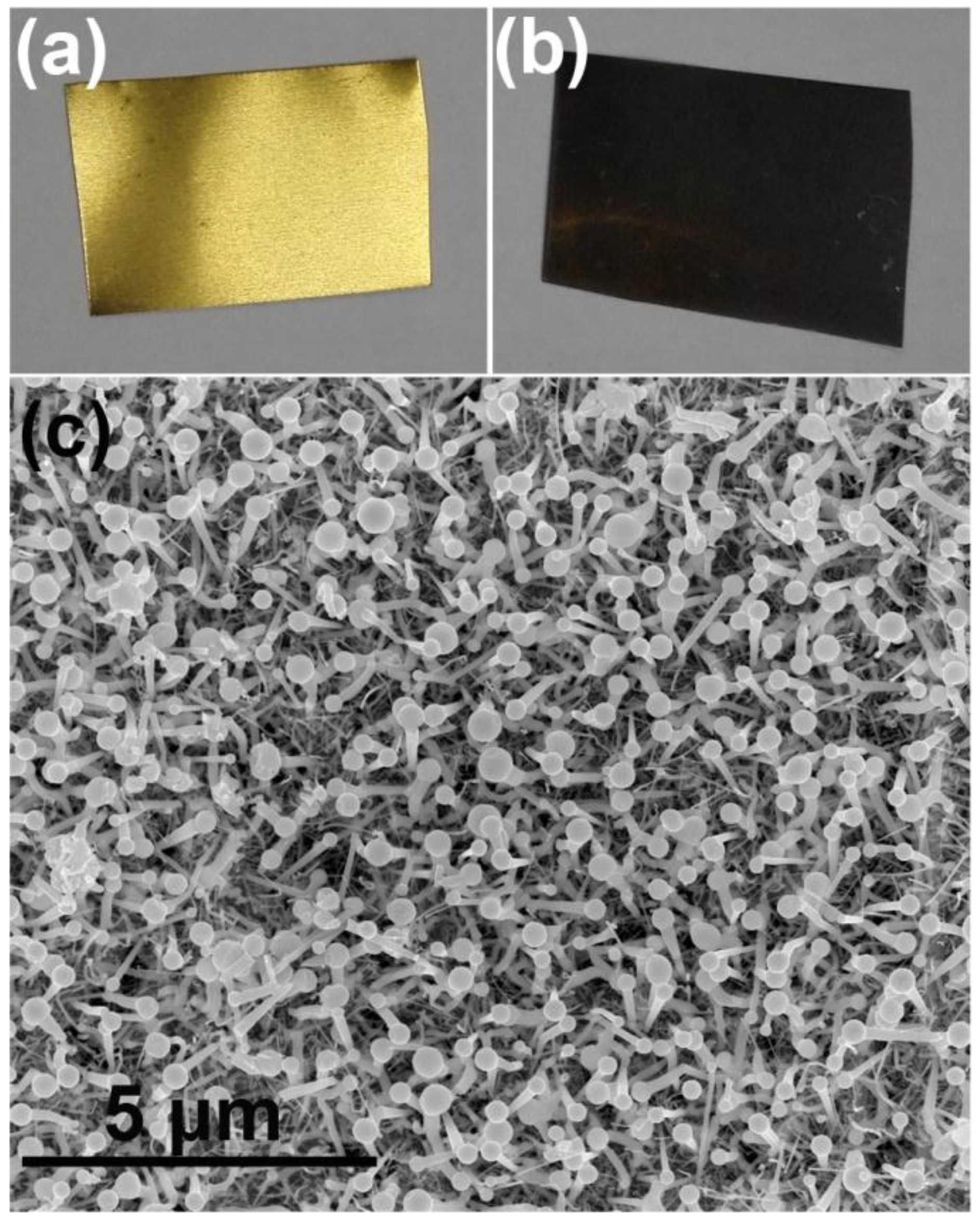
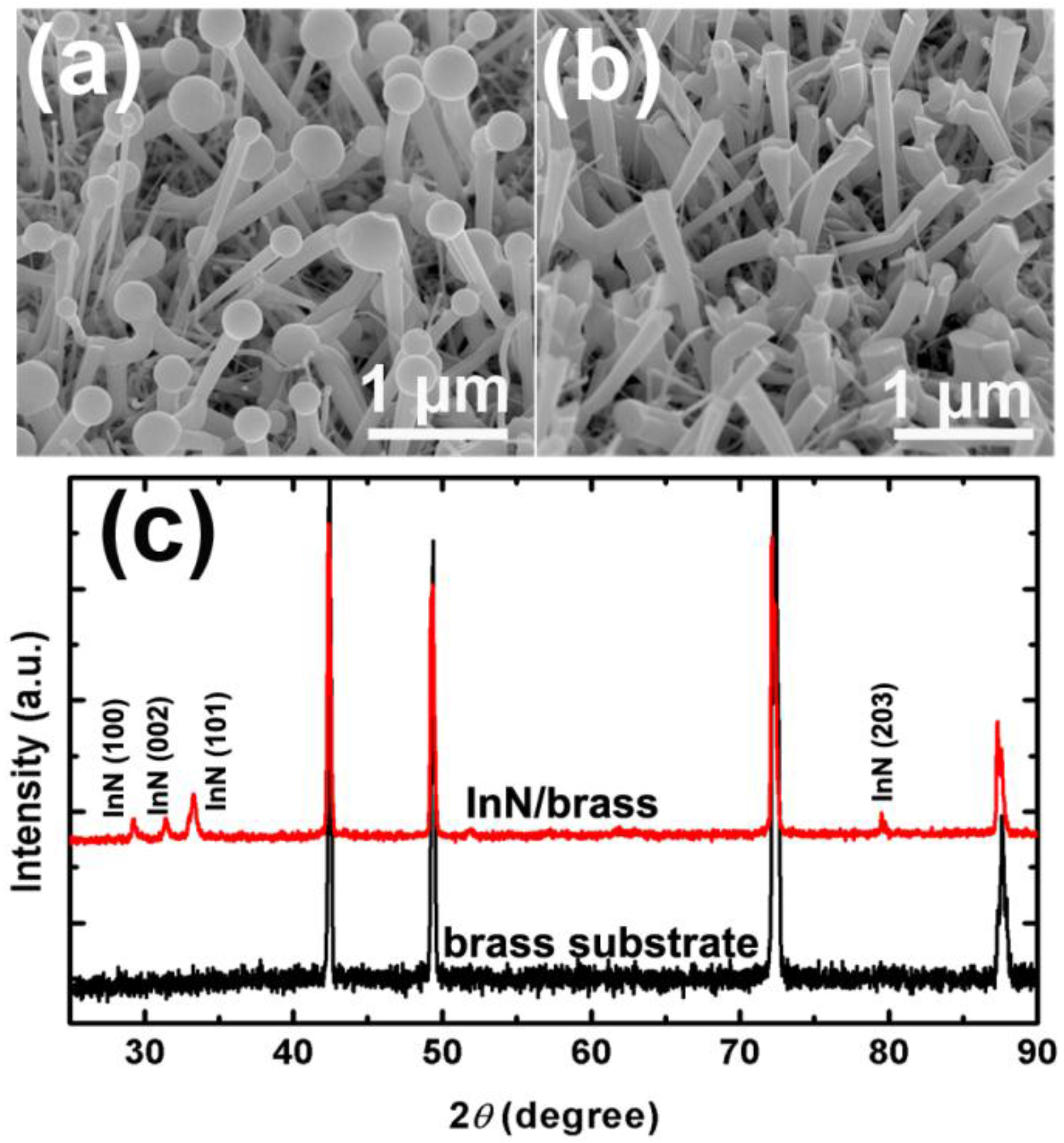
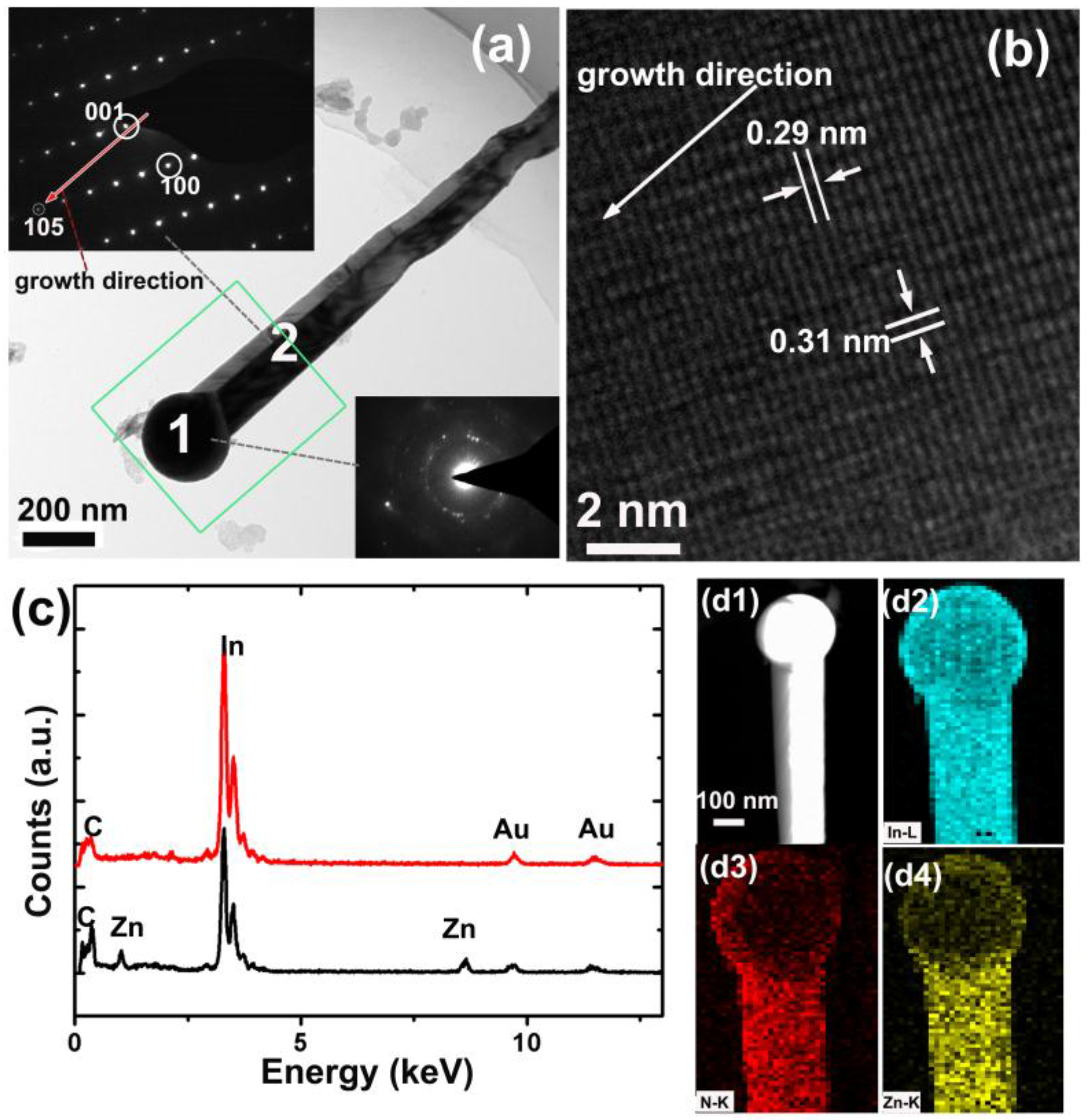

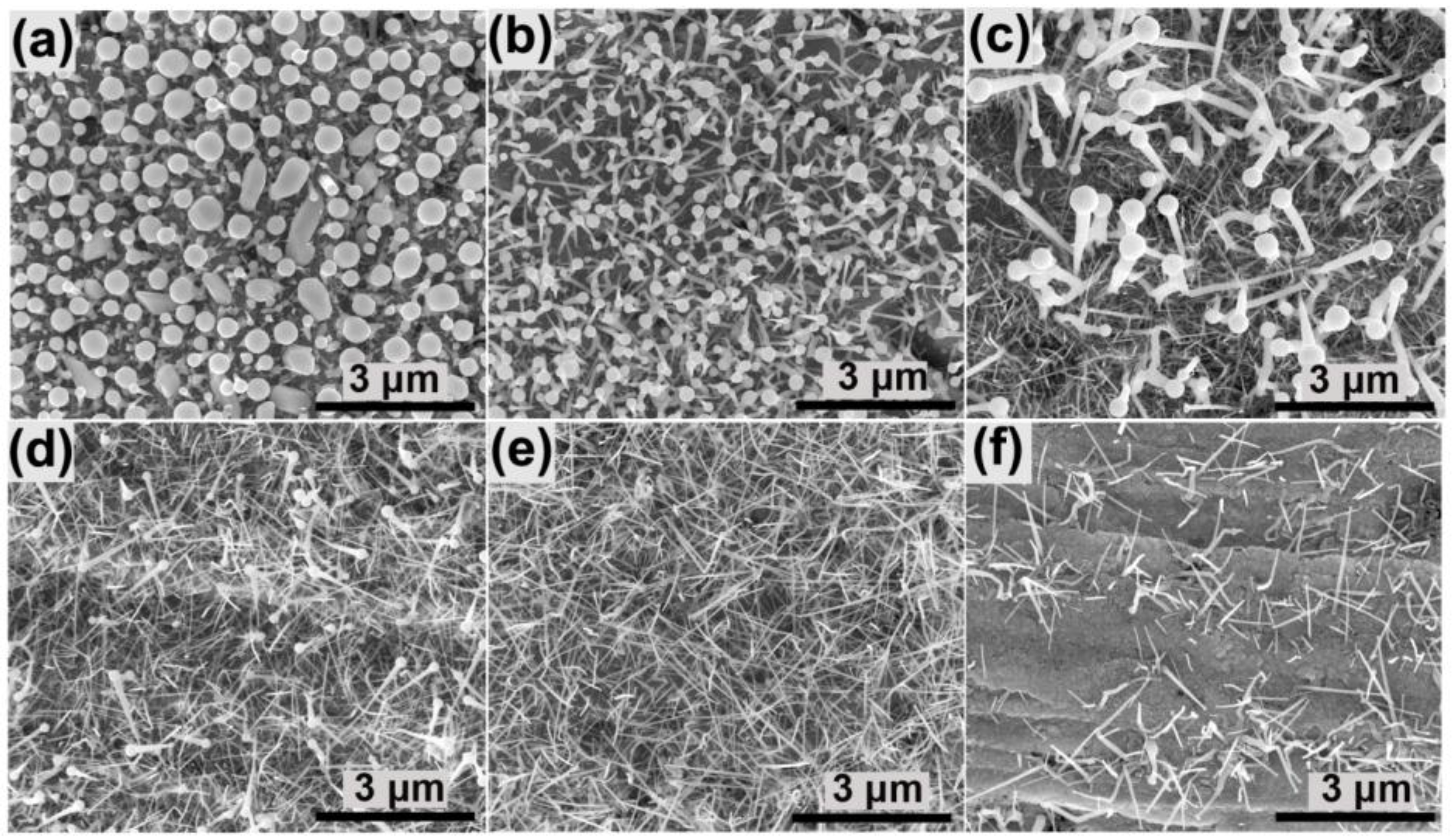

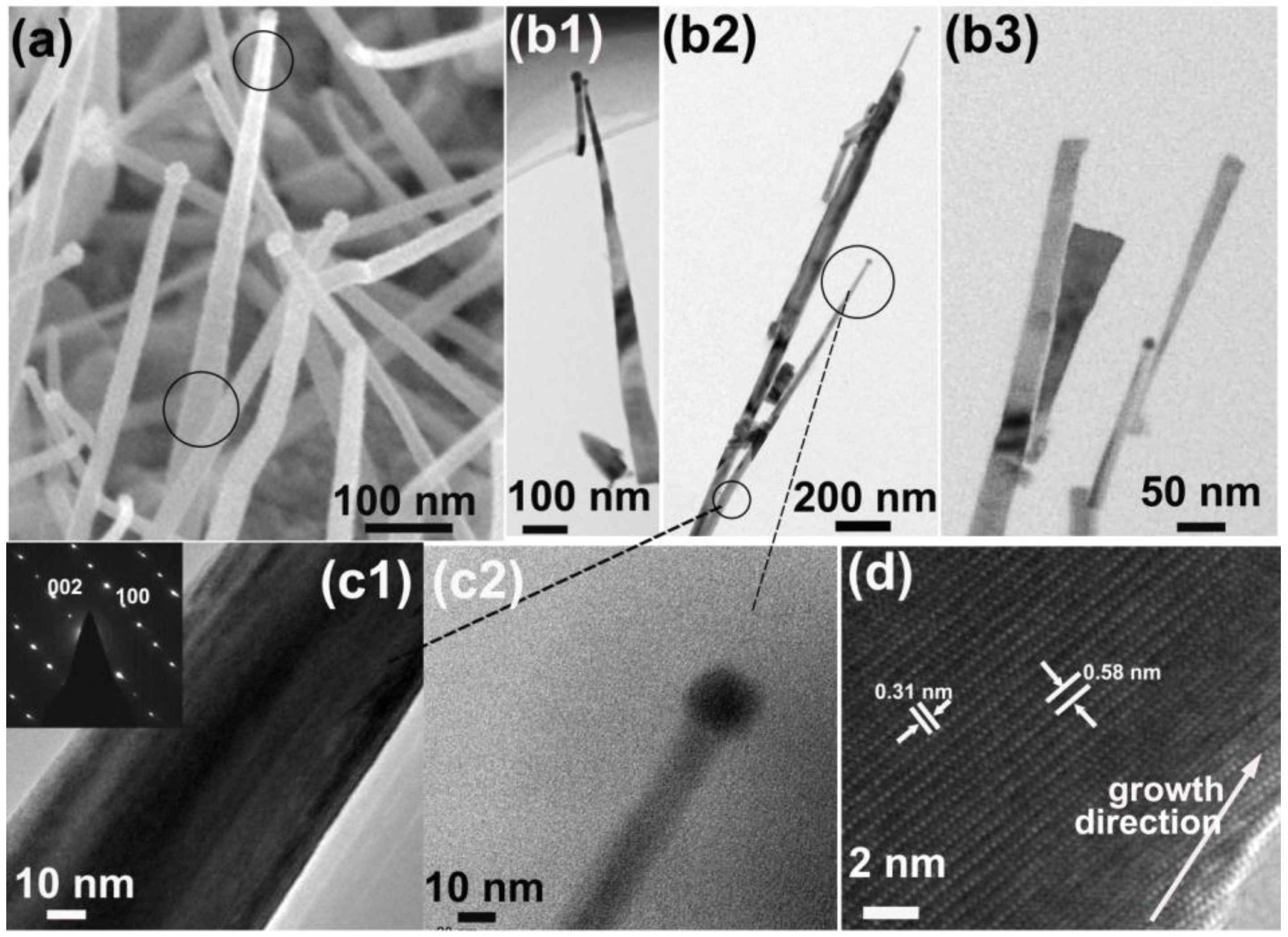



© 2016 by the authors; licensee MDPI, Basel, Switzerland. This article is an open access article distributed under the terms and conditions of the Creative Commons Attribution (CC-BY) license (http://creativecommons.org/licenses/by/4.0/).
Share and Cite
Li, H.; Zhao, G.; Wang, L.; Chen, Z.; Yang, S. Morphology Controlled Fabrication of InN Nanowires on Brass Substrates. Nanomaterials 2016, 6, 195. https://doi.org/10.3390/nano6110195
Li H, Zhao G, Wang L, Chen Z, Yang S. Morphology Controlled Fabrication of InN Nanowires on Brass Substrates. Nanomaterials. 2016; 6(11):195. https://doi.org/10.3390/nano6110195
Chicago/Turabian StyleLi, Huijie, Guijuan Zhao, Lianshan Wang, Zhen Chen, and Shaoyan Yang. 2016. "Morphology Controlled Fabrication of InN Nanowires on Brass Substrates" Nanomaterials 6, no. 11: 195. https://doi.org/10.3390/nano6110195





